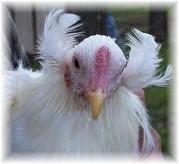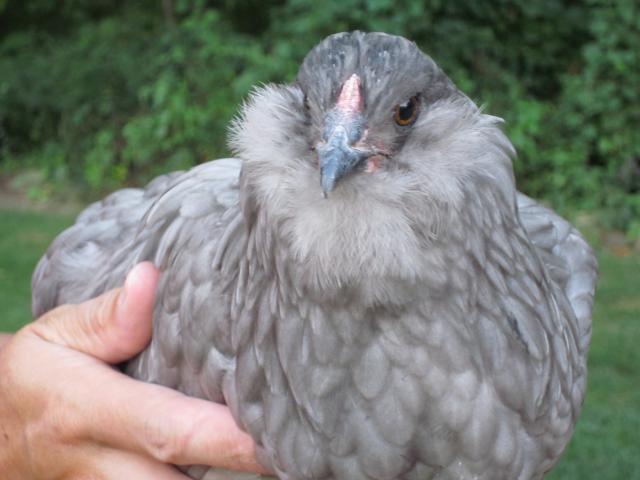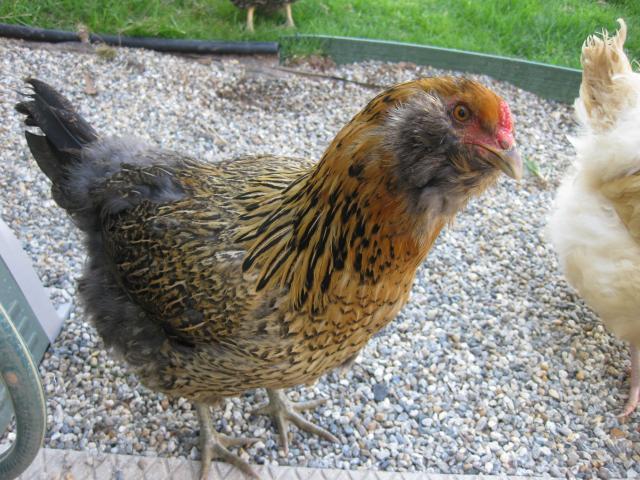What is the difference between an Araucana, Ameraucana and Easter Egger chicken? If youre confused, youre not alone. Even the experts disagree on some aspects of the histories of these chickens. I hope the following clears up a few of the basics for you. (this article is from my blog, http://www.eggcartonlabels.blogspot.com, the article in particular is here: http://networkedblogs.com/muYl3 )
ARAUCANAS

photo reprinted with permission of http://hinkjcpoultry.com
Araucanas were recognized by the American Poultry Association (APA) as a breed in 1976. They are blue egg layers with yellow skin, no tails, no beards and no muffs. They possess ear tufts, which are feathers that grow from a slender, fleshy flap just below the ear. The APA recognizes five colors of Araucana: Black, Black Breasted Red, Golden Duckwing, Silver Duckwing and White.
Araucanas were first bred in the United States in the 1930's. They came from a cross between two breeds from Northern Chile, Colloncas and Quetros. Colloncas have no ear tufts but are rumpless and lay blue eggs; Quetros have ear tufts and tails but do not lay blue eggs. (http://www.araucana.net/images/ACA_Images/Araucana_Alan_Stanford_Article.pdf)
Araucanas are frequently confused with Ameraucanas and Easter Eggers, not only due to misinformation, but often knowingly by unscrupulous sellers. Araucanas are scarce in the United States, likely due to the genetic challenges in breeding. The tufted gene in Araucana is a lethal gene. Two copies of the gene cause nearly 100% mortality in offspring (usually between days 18-21 of incubation). Because no living Araucana possesses two copies of the tufted gene, breeding any two tufted birds leads to half of the resulting chicks being tufted with one copy of the gene, one quarter of the chicks being clean-faced with no copy of the gene, and one quarter of the embryos dead in the shell, having received two copies of the gene.
http://www.ansi.okstate.edu/breeds/poultry/chickens/araucana/
http://www.araucana.net/
http://www.araucana.net/images/ACA_Images/Araucana_Alan_Stanford_Article.pdf
http://www.araucana.com/index2.htm
AMERAUCANAS

Ameraucanas have been bred from different strains of Araucanas since at least 1960 in the United States. The American Poultry Association recognized Ameraucanas as a breed in 1984. For an extraordinarily thorough and fascinating history of Ameraucanas, please see http://www.ameraucana.org/history.html:
Ameraucanas lay blue eggs. Other traits include a pea comb, white skin, full tails, muffs and beards (always together), and slate or black legs; they have no ear tufts. The APA recognizes these colors: Black, Blue, Blue Wheaten, Brown Red, Sliver, Wheaten and White.
While Ameraucanas are more common in the United States than Araucanas, they are available only through reputable breeders, regardless of advertisements by hatcheries and other large-scale, distribution sources. If you are in the market for Ameraucanas and see an advertisement for "Americanas," be forewarned: there is no such breed.
http://www.ameraucana.org/history.htmlhttp://www.ameraucana.org/history.html
http://www.ameraucana.org/scrapbook.html
EASTER EGGERS

Easter Eggers (EEs) are not an APA recognized breed, they are a mix of different breeds. They are essentially descendants of Araucanas and Ameraucanas on one side of the family, and any other breed on the other side of the family. Easter Eggers do not breed true. To "breed true" means that purebred chicks resemble both parents.
According to the Easter Egg Club of America, EEs are "the most popular chicken in America today."* Easter Eggers lay a wide range of egg colors, including: any hue of blue and green and even pink on occasion. Other common EE traits include pea combs and wattles that are either small or absent. They often have greenish legs and beards and muffs, but not always. They can have any skin color. They often have beards and muffs, but not necessarily. Their leg color can range from green to slate and even yellow. They can be found in an infinite array of feather colors, which makes them a beautiful and unique. Easter Eggers are like a box of chocolates, you never know what you're going to get!
http://www.eastereggers.com/
ARAUCANAS

photo reprinted with permission of http://hinkjcpoultry.com
Araucanas were recognized by the American Poultry Association (APA) as a breed in 1976. They are blue egg layers with yellow skin, no tails, no beards and no muffs. They possess ear tufts, which are feathers that grow from a slender, fleshy flap just below the ear. The APA recognizes five colors of Araucana: Black, Black Breasted Red, Golden Duckwing, Silver Duckwing and White.
Araucanas were first bred in the United States in the 1930's. They came from a cross between two breeds from Northern Chile, Colloncas and Quetros. Colloncas have no ear tufts but are rumpless and lay blue eggs; Quetros have ear tufts and tails but do not lay blue eggs. (http://www.araucana.net/images/ACA_Images/Araucana_Alan_Stanford_Article.pdf)
Araucanas are frequently confused with Ameraucanas and Easter Eggers, not only due to misinformation, but often knowingly by unscrupulous sellers. Araucanas are scarce in the United States, likely due to the genetic challenges in breeding. The tufted gene in Araucana is a lethal gene. Two copies of the gene cause nearly 100% mortality in offspring (usually between days 18-21 of incubation). Because no living Araucana possesses two copies of the tufted gene, breeding any two tufted birds leads to half of the resulting chicks being tufted with one copy of the gene, one quarter of the chicks being clean-faced with no copy of the gene, and one quarter of the embryos dead in the shell, having received two copies of the gene.
http://www.ansi.okstate.edu/breeds/poultry/chickens/araucana/
http://www.araucana.net/
http://www.araucana.net/images/ACA_Images/Araucana_Alan_Stanford_Article.pdf
http://www.araucana.com/index2.htm
AMERAUCANAS

Ameraucanas have been bred from different strains of Araucanas since at least 1960 in the United States. The American Poultry Association recognized Ameraucanas as a breed in 1984. For an extraordinarily thorough and fascinating history of Ameraucanas, please see http://www.ameraucana.org/history.html:
Ameraucanas lay blue eggs. Other traits include a pea comb, white skin, full tails, muffs and beards (always together), and slate or black legs; they have no ear tufts. The APA recognizes these colors: Black, Blue, Blue Wheaten, Brown Red, Sliver, Wheaten and White.
While Ameraucanas are more common in the United States than Araucanas, they are available only through reputable breeders, regardless of advertisements by hatcheries and other large-scale, distribution sources. If you are in the market for Ameraucanas and see an advertisement for "Americanas," be forewarned: there is no such breed.
http://www.ameraucana.org/history.htmlhttp://www.ameraucana.org/history.html
http://www.ameraucana.org/scrapbook.html
EASTER EGGERS

Easter Eggers (EEs) are not an APA recognized breed, they are a mix of different breeds. They are essentially descendants of Araucanas and Ameraucanas on one side of the family, and any other breed on the other side of the family. Easter Eggers do not breed true. To "breed true" means that purebred chicks resemble both parents.
According to the Easter Egg Club of America, EEs are "the most popular chicken in America today."* Easter Eggers lay a wide range of egg colors, including: any hue of blue and green and even pink on occasion. Other common EE traits include pea combs and wattles that are either small or absent. They often have greenish legs and beards and muffs, but not always. They can have any skin color. They often have beards and muffs, but not necessarily. Their leg color can range from green to slate and even yellow. They can be found in an infinite array of feather colors, which makes them a beautiful and unique. Easter Eggers are like a box of chocolates, you never know what you're going to get!
http://www.eastereggers.com/
Last edited:











